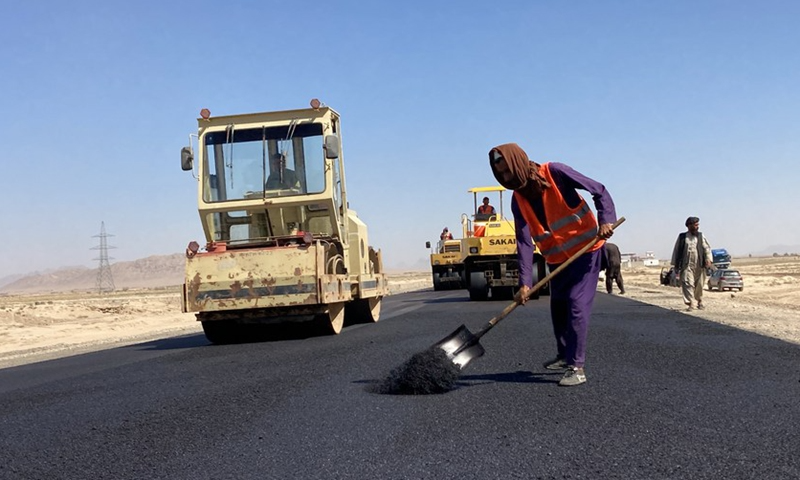Afghanistan’s Questionable Infrastructure Projects and Unclear Financing Sources
While the Taliban have embarked on large-scale infrastructure projects to showcase effective governance, a recent report by the Observer Research Foundation (ORF) reveals that the funding sources for these projects remain unclear, unstable, and heavily dependent on informal revenues and local taxes. This raises serious questions about the sustainability and durability of Afghanistan’s connectivity programs.

DIDPress: Since taking power, the Taliban have launched several connectivity and infrastructure projects across Afghanistan aiming to present an image of effective governance. However, the financial model behind these projects remains ambiguous and controversial. Funding sources are not clearly identified, and budget allocations appear uneven.
Assessing Afghanistan’s Infrastructure Projects
Since 2021, the Taliban have tried to transform themselves from a rebel group into a governing body. Central to this transition are ambitious plans to leverage Afghanistan’s geostrategic position at the crossroads of Central and South Asia to become a regional connectivity hub. Investments in infrastructure projects aimed at reviving the national economy and integrating it into broader regional trade networks reflect this vision. Yet, these investments are influenced by complex political and economic factors, casting doubt on the Taliban’s ability to fulfill their commitments.
Major Infrastructure Projects in Afghanistan
- Mazar-i-Sharif – Herat – Kandahar Railway
- Status: Under construction
- Financing: No clear budget details. The interim government claims the project will be funded domestically.
- Trans-Afghan Multimodal Transport Corridor
- Status: In planning phase
- Financing: Estimated cost $5 million, funded by multiple sources. A feasibility study agreement was signed in February 2024 between Afghanistan’s National Railway Authority, UAE, and Uzbekistan.
- Turghundi – Herat – Kandahar – Spin Boldak Railway Network
- Status: Under construction/planning
- Financing: Kazakhstan pledged $500 million; implementation to be jointly carried out with Turkmenistan.
- TAPI Pipeline (Turkmenistan-Afghanistan-Pakistan-India)
- Status: Under construction
- Financing: Estimated cost over $10 billion. Supported by the four countries involved and international bodies like the Asian Development Bank.
- Wakhan Corridor Highway
- Status: Under construction (initial phase completed; phase two to begin soon)
- Financing: Ministry of Rural Rehabilitation and Development oversees implementation. Phase two contracted to a private company.
- Agreement with Turkmenistan (Herat-Turghundi station, Aqina-Andkhoy railway, Andkhoy-Sheberghan survey)
- Status: Operational (10 km of Aqina-Andkhoy railway active)
- Financing: $7 million agreement between Afghanistan and Turkmenistan.
- Chabahar Port
- Status: Under construction
- Financing: Interim government committed $35 million for development in March 2024.
- Khaf-Herat Railway Network
- Status: Operational since December 2020; final phase expected by March 2026
- Financing: Funded by Iran, total project cost $75 million.
- Expansion of China-Pakistan Economic Corridor (CPEC) to Afghanistan
- Status: Proposal stage
- Financing: China and Pakistan agreed to extend CPEC to Afghanistan; part of China’s Belt and Road Initiative (BRI).
- CASA-1000 Power Transmission Project
- Status: Under construction
- Financing: Funded by the World Bank, European Investment Bank, Islamic Development Bank, European Bank for Reconstruction and Development, UK’s FCDO, and USAID.
Financing Ambiguities and Challenges
The Taliban finance these projects through a mix of public contributions, local taxes—especially from small businesses—and customs duties collected at strategic border crossings. Increasing reliance on internal resource extraction highlights their financial fragility, compounded by the freezing of approximately $9.5 billion in Afghanistan’s foreign reserves.
The Taliban’s broader infrastructure strategy focuses on regional connectivity projects aimed at integrating Afghanistan into economic corridors spanning Central and South Asia. A significant step has been investing in Iran’s Chabahar Port, with a $35 million allocation reducing Afghanistan’s dependence on Pakistan’s Karachi Port. This push for connectivity is further reinforced by deepening trade relations with Iran.
Motivations Behind Connectivity Efforts
The interim government’s aggressive pursuit of regional connectivity projects stems from a combination of political, economic, and strategic motives. Domestically, these projects serve as symbols of governance, showcasing functionality in the absence of democratic institutions.
However, the Taliban’s financial model remains heavily dependent on public taxation, trade, and informal remittance networks, raising concerns about the long-term viability of these initiatives.
Moreover, such infrastructure projects provide economic incentives for tribal leaders and local warlords, which may reduce internal conflicts and contribute to more stable and cohesive governance. This economic inclusion strategy can diminish local resistance and support the consolidation of a unified administrative structure.
Conclusion
The interim government’s drive to develop infrastructure and regional connectivity is not merely about economic growth; it is a multilayered strategy aimed at achieving financial independence, political legitimacy, and regional influence.
Yet, domestic instability, regional rivalries, and security threats continue to cast a shadow over these ambitions. Whether Afghanistan can successfully transform into a regional trade hub or remain a fragile transit point depends largely on the Taliban’s capacity to manage financial constraints, security risks, and diplomatic isolation.